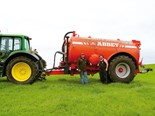Farming nutrient loss reduction costs vary in study
Case studies of dairy support farms in the Upper Waikato River catchment indicate that the effect on profits of reducing their nutrient losses to water is as variable as the systems themselves and could potentially be minimal.
Improvements in productivity and efficiency could hold the key to minimising any negative financial impact from reducing such losses, the studies found.
The information will be made available to farmers to help improve their business efficiency and reduce the environmental impact of their operations, as well as to other interested parties.
Dairy support farms provide grazing and feed crops for dairy farmers. These farms have a vital role in the economics of both dairy and drystock industries so it is important to understand the risks and opportunities involved.
The Waikato Regional Council-funded case studies of eleven farms were conducted by Perrin Ag Consultants Ltd and carried out under the guidance of a working party which included iwi, farm consultancy, dairy, sheep and beef, arable and fertilizer industry representatives.
The studies were designed to understand more about dairy support farm systems, how they might be managed to reduce losses of nutrients to waterways and groundwater, and to look at any other issues identified.
The project examined nitrogen leaching, phosphorus run-off, sediment loss and micro-organism loss. It also studied what could be done to prevent these losses and the costs involved.
Reducing nitrogen loss by 10 percent and 20 percent was modelled as was one sediment and phosphorus loss reduction scenario.
The study report said reductions in current nitrogen losses from dairy support operations in the Upper Waikato in the order of 10 percent could possibly be achieved with minimal economic disruption in terms of the impact on farm earnings. However, reductions of more than that would contribute to a loss in profitability. Results would vary for individual properties.
Under the 10 percent loss reduction scenario, the average change in earnings before interest and tax (EBIT) associated with reducing nitrogen losses was $7 a hectare per year and $21 hectare under a 20 percent reduction scenario.
But the report also said improvement in farm productivity may hold the key to many farms reducing their nitrogen losses to waterways without any significant negative financial impact. It acknowledged such improvements will not easily be achieved in the short-term and continued investment in on-farm research and farmer advice will likely be required.
The study report said the financial impact of reducing phosphorus losses was less certain. For the five farms subjected specifically to phosphorus loss analysis, there was a wide range of positive and negative EBIT impacts, with an average profit reduction of just 60 cents a hectare.
The regional council’s Upper Waikato Catchment sustainable agriculture advisor Jon Palmer said the data provided interesting technical advice for farmers and other interested parties.
Farmers and their consultants would find the report helpful in identifying their options when limits and targets are established for the catchment under the Healthy Rivers/Wai Ora project, Mr Palmer said.
A full copy of the dairy support case studies report is available here.
For the latest news and farm machinery reviews, subscribe to Farm Trader magazine here.
Keep up to date in the industry by signing up to Farm Trader's free newsletter or liking us on Facebook

.jpg)












